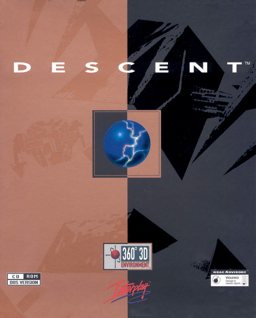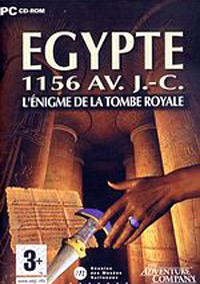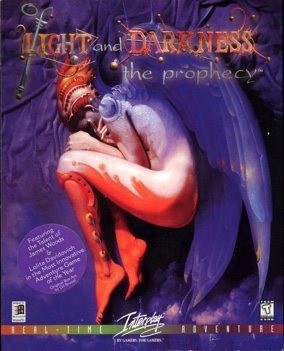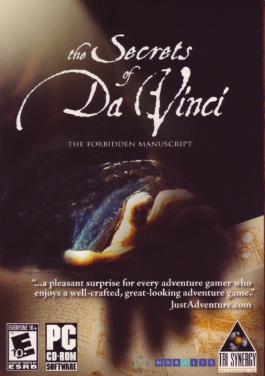
Descent is a first-person shooter (FPS) game developed by Parallax Software and released by Interplay Productions in 1995 for MS-DOS, and later for Macintosh, PlayStation, and RISC OS. It popularized a subgenre of FPS games employing six degrees of freedom and was the first FPS to feature entirely true-3D graphics. The player is cast as a mercenary hired to eliminate the threat of a mysterious extraterrestrial computer virus infecting off-world mining robots. In a series of mines throughout the Solar System, the protagonist pilots a spaceship and must locate and destroy the mine's power reactor and escape before being caught in the mine's self-destruction, defeating opposing robots along the way. Players can play online and compete in either deathmatches or cooperate to take on the robots.

Troika Games was an American video game developer co-founded by Jason Anderson, Tim Cain, and Leonard Boyarsky. The company was focused on role-playing video games between 1998 and 2005, best known for Arcanum: Of Steamworks and Magick Obscura and Vampire: The Masquerade – Bloodlines.

Pyst is an adventure computer game released in October 1996. It was created as a parody of the highly successful adventure game Myst. Pyst was written by Peter Bergman, a co-founder of the Firesign Theatre, and was published by Parroty Interactive, with Bergman, Stallone, Inc. as co-publisher. Mindscape began distributing the game on August 20, 1997. The parody features full motion video of actor John Goodman as "King Mattruss", the ruler of "Pyst Island". Versions of the game were produced for both the Windows PC and Apple Macintosh operating systems.

Titanic: Adventure Out of Time is a 1996 point-and-click adventure game developed by CyberFlix and published in the United States and United Kingdom by GTE Entertainment and Europress respectively, for Microsoft Windows and Macintosh. It takes place in a virtual representation of the RMS Titanic, with the player assuming the role of a British spy who has been sent back in time to the final night of the Titanic and must complete a previously failed mission to prevent World War I, the Russian Revolution, and World War II from occurring. The gameplay involves exploring the ship and solving puzzles. There are multiple outcomes and endings to the game depending on the player's interactions with characters and use of items.

Descent II is a 1996 first-person shooter game developed by Parallax Software and first published for DOS by Interplay Productions. For the PlayStation, it is known as Descent Maximum. It is the second installment in the Descent video game series and the sequel to Descent. The base of the gameplay remaining the same, the player controls a spaceship from the pilot's perspective and must navigate extrasolar underground mines to locate and destroy their reactors and escape being caught in their self-destructions, while engaging and surviving infected robots, which will attempt to destroy the ship. Unlike other first-person shooters, its six-degrees-of-freedom scheme allows the player to move and rotate in any three-dimensional space and direction.

Princess Maker 2 is a 1993 Japanese video game developed by the company Gainax. It is the second installment in the Princess Maker series of social simulation games where the player must act as a parental figure and raise a young girl. The player takes role of a War Hero who raises a girl to the age of 18. At the end of the game, the daughter goes into a line of work; what this work is, how much talent she has for it, her marital life, and her overall happiness all depend on the player's actions throughout the game.

PowerSlave, known as Exhumed in Europe and 1999 AD: Resurrection of the Pharaoh in Japan, is a first-person shooter video game developed by Lobotomy Software and published by Playmates Interactive in North America, and BMG Interactive in Europe and Japan. It was released in North America, Europe and Japan, for the Sega Saturn, PlayStation, and MS-DOS over the course of a year from late 1996 to late 1997. On May 24, 2015, Powerslave EX, an unofficial remake for the PlayStation version appeared on GitHub. The MS-DOS version of PowerSlave was added to the GOG store on November 19, 2020.

Atomic Bomberman is a game by Interplay Productions for the PC that was released in 1997. It was the first original Bomberman game to be developed for Windows, and the second game of the series made for the PC, following Dynablaster.

Frankenstein: Through the Eyes of the Monster is a point-and-click adventure video game that stars Tim Curry as Dr. Frankenstein, and has the player controlling a newly created Frankenstein monster. Other cast members include Robert Rothrock as the voice of the monster, Rebecca Wink as villager Sara, and Amanda Fuller as Gabrielle, the monster's daughter. It used full motion video clips and 3D CGI graphics similar to Myst. The game was developed by Amazing Media and published by Interplay Entertainment Corp for the PC in 1995 and for the Sega Saturn in 1997. The game was given a "Teen" rating by the Entertainment Software Rating Board, but was originally rated as K-A. A port for the Atari Jaguar was in development but never released.
The Mummy is an action adventure horror film media franchise based on films by Universal Pictures about a mummified ancient Egyptian priest who is accidentally resurrected, bringing with him a powerful curse, and the ensuing efforts of heroic archaeologists to stop him. The franchise was created by Nina Wilcox Putnam and Richard Schayer.

Egypt 1156 B.C. – Tomb of the Pharaoh ( ) is a 1997 adventure video game co-published by Cryo Interactive Entertainment, Canal+ Multimedia and the Réunion des Musées Nationaux for the Microsoft Windows and PlayStation. It was later released in North America by DreamCatcher Interactive.

The Cameron Files: Pharaoh's Curse is an adventure video game released in 2002, developed by Galilea and published by DreamCatcher Interactive and The Adventure Company.

Mummies are commonly featured in horror genres as undead creatures wrapped in bandages. Similar undead include skeletons and zombies.

Of Light and Darkness: The Prophecy, also known as simply Of Light and Darkness, is a first-person point-and-click adventure video game developed by Tribal Dreams and published by Interplay Entertainment in 1998.

Byzantine: The Betrayal is a video game, released September 30, 1997 for Microsoft Windows.

Cydonia: Mars - The First Manned Mission is a 1998 adventure video game, and the premiere title for developer Aneiva Interactive.

Virtual Snooker is a sports simulation video game developed by Celeris and published by Interplay Productions as an entry in the Virtual Pool franchise, the second in the series after Virtual Pool and the first spin-off from pool games, focusing on the game of snooker. The game was released on DOS in July 1996 and is the first game in the series game to contain snooker as a playable game.

The Secrets of Da Vinci: The Forbidden Manuscript is an adventure game developed by Kheops Studio and published by Tri Synergy on June 7, 2006 on the PC. In 2009 it was released on the Mac OS X.

Skull Cracker is a 1996 supernatural beat 'em up video game developed by American studio CyberFlix and published by GTE Entertainment on Macintosh and Windows. It is sometimes considered a spiritual successor to the 1991 title Creepy Castle, which the game's head of technology William Appleton had previously written for Reactor Inc. Skull Cracker was conceptually designed by Ben Calica.



















